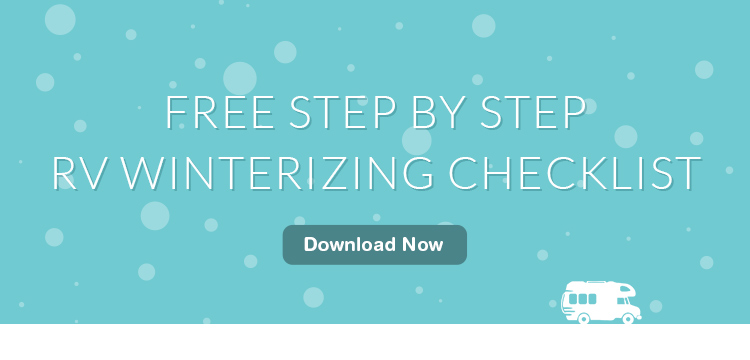Parking your RV for the winter requires preventive measures to prepare it for the following spring. Our easy-to-follow, printable, Step By Step RV Winterizing Checklist is the essential guide for RV owners in Alberta. Learn RV winterizing basics, such as what temperature to winterize your RV and how much RV antifreeze is needed.
Table of Contents
ToggleWhat Temperature Should You Winterize Your RV?
Once temperatures reach 0℃ (or below), it’s time to get your RV ready for storage. Winter weather in Alberta can hit suddenly, and you don’t want to be caught not having winterized your RV.
How Much RV Antifreeze Is Needed To Winterize An RV?
The amount of RV antifreeze required depends on the layout and length of your RV plumbing lines. We recommend buying 2-3 gallons of non-toxic, pink antifreeze.
Download Your Free RV Winterizing Checklist

How To Winterize Your RV:
Make Your Own RV Winterization Kit
Before you get started there are a few items you will need to have in your arsenal. These items can be found in our RV parts department:
- Non-toxic RV antifreeze
- A water heater by-pass kit, if not already installed
- A wand to clean out holding tanks
- A water pump converter kit or tubing to connect to the inlet side of the water pump
- Basic hand tools to remove drain plugs
Winterize Your Water System with Antifreeze
Follow these simple steps to ensure your RV bounces back to life in the spring:
- Drain your greywater and blackwater tanks at an RV dump station, and clean out your RV’s blackwater tank with a wash wand.
- Disconnect any external water sources from your RV.
- Make sure your hot water tank is off and the system is cool before proceeding.
- Ensure your hot water system is depressurized by turning on your hot and cold water faucets.
- Turn on/open other water valves, such as the toilet and any outside kitchen or shower.
- You’ll have to find your low point water drains and open them up to drain as well.
- Your water pump will help to evacuate the water lines completely, and it should be turned off once this is done.
- Once the water is drained, close the valves, drains and faucets.
- At this point, you’ll want to bypass your RV water heater so you don’t fill it with gallons and gallons of RV antifreeze.
- You can bypass your water heater with a converter kit, but it may already have a bypass installed.
- Presuming your water pump also has a bypass on it (if not, you’ll need to install one), connect a tube on the inlet side (you’ll have to disconnect the water inlet) and insert the tube into your RV antifreeze container.
- The system should now be pressurized by turning on your water pump.
- Starting with faucets close to the pump, going one by one, you’ll need to turn them on until the RV antifreeze begins to pour out. Shut each faucet off.
- Keep going until they’re all done, including any external faucets and valves (for example, an outdoor shower).
- Each drain should also have a cup or two of antifreeze poured in.
- The toilet should be flushed until you see antifreeze.

Other Steps Required To Winterize Your RV
Remove All Batteries – turn off the RV’s disconnect and breaker switches. Store fully charged RV batteries in a warm, dry spot.
Protect RV Exterior – clean the exterior of your RV, patch cracks and split seams. Cover entire exterior with a good quality wax or protectant formula. Make sure that external vents and other entry points are covered and closed to prevent mice and other creatures from finding a home in your RV for the winter.
Clean And Dry Your Awning – this prevents moulding. Same goes for any trailers with fabric or canvas siding.
Remove, Clean and Replace A/C Filters – clean the exterior of your air conditioning unit. Remove, clean, and replace air conditioner filters before storing for winter.
Service Locks And Hinges – lubricate your locks and hinges to avoid creaks, jams, and breaks in the spring.
Tidy And Clean The Interior – remove all clothing and blankets and store at home. Leave all cushions and mattresses propped against a wall for optimal airflow.
Cover Your RV Wheels – if storing outside, covering your wheels will protect them from the winter elements.

